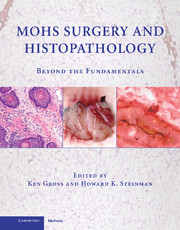Book contents
- Frontmatter
- Contents
- CONTRIBUTORS
- MOHS SURGERY AND HISTOPATHOLOGY
- PART I MICROSCOPY AND TISSUE PREPARATION
- Chap. 1 INTRODUCTION
- Chap. 2 HOW TO EXCISE TISSUE FOR OPTIMAL SECTIONING
- Chap. 3 OPTIMIZING THE MOHS MICROSCOPE
- Chap. 4 TISSUE PREPARATION AND CHROMACODING
- Chap. 5 EMBEDDING TECHNIQUES
- PART II INTRODUCTION TO LABORATORY TECHNIQUES
- PART III MICROANATOMY AND NEOPLASTIC DISEASE
- PART IV SPECIAL TECHNIQUES AND STAINS
- INDEX
- References
Chap. 1 - INTRODUCTION
from PART I - MICROSCOPY AND TISSUE PREPARATION
Published online by Cambridge University Press: 03 March 2010
- Frontmatter
- Contents
- CONTRIBUTORS
- MOHS SURGERY AND HISTOPATHOLOGY
- PART I MICROSCOPY AND TISSUE PREPARATION
- Chap. 1 INTRODUCTION
- Chap. 2 HOW TO EXCISE TISSUE FOR OPTIMAL SECTIONING
- Chap. 3 OPTIMIZING THE MOHS MICROSCOPE
- Chap. 4 TISSUE PREPARATION AND CHROMACODING
- Chap. 5 EMBEDDING TECHNIQUES
- PART II INTRODUCTION TO LABORATORY TECHNIQUES
- PART III MICROANATOMY AND NEOPLASTIC DISEASE
- PART IV SPECIAL TECHNIQUES AND STAINS
- INDEX
- References
Summary
MOHS SURGERY will remain the gold standard for the treatment of skin cancer until immunotherapy or other nondestructive modalities replace current surgical treatments. It allows skin cancer removal with higher cure rates and greater sparing of normal tissues than other excisional techniques. Mohs surgery accomplishes this in an office setting and at reasonable cost when practiced in an optimal fashion.
There are some common misconceptions about Mohs surgery that may stand in the way of optimizing the technique and that may unnecessarily increase its cost.
MISCONCEPTION 1
Mohs surgery is first and foremost about tissue sparing. It is not; Mohs surgery's first goal is complete cancer removal. A focus on tissue sparing leads some Mohs surgeons to excise specimens with very narrow surgical margins even from areas where taking wider margins would not compromise function or closure. There are clearly many situations where excising wider margins would allow fewer stages of surgery, lower surgical costs, and would not substantively change the type of closure or lead to any cosmetic or functional degradation. In addition, if tissue sparing were the main goal of treatment, other modalities such as cryotherapy, radiation, and in selected cancers, presently available immunotherapy such as interferon alfa-2b and imiquimod would spare tissue to a greater extent while compromising cure rates by less than 5–10%.
- Type
- Chapter
- Information
- Mohs Surgery and HistopathologyBeyond the Fundamentals, pp. 3 - 4Publisher: Cambridge University PressPrint publication year: 2009



